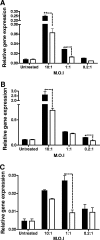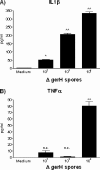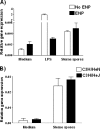Role of Bacillus anthracis spore structures in macrophage cytokine responses
- PMID: 17339355
- PMCID: PMC1865778
- DOI: 10.1128/IAI.01982-06
Role of Bacillus anthracis spore structures in macrophage cytokine responses
Abstract
The innate immune response of macrophages (Mphi) to spores, the environmentally acquired form of Bacillus anthracis, is poorly characterized. We therefore examined the early Mphi cytokine response to B. anthracis spores, before germination. Mphi were exposed to bacilli and spores of Sterne strain 34F2 and its congenic nongerminating mutant (DeltagerH), and cytokine expression was measured by real-time PCR and an enzyme-linked immunosorbent assay. The exosporium spore layer was retained (exo+) or removed by sonication (exo-). Spores consistently induced a strong cytokine response, with the exo- spores eliciting a two- to threefold-higher response than exo+ spores. The threshold for interleukin-1beta (IL-1beta) production by wild-type Mphi was significantly lower than that required for tumor necrosis factor alpha expression. Cytokine production was largely dependent on MyD88, suggesting Toll-like receptor involvement; however, the expression of beta interferon in MyD88-/- Mphi suggests involvement of a MyD88-independent pathway. We conclude that (i) the B. anthracis spore is not immunologically inert, (ii) the exosporium masks epitopes recognized by the Mphi, (iii) the Mphi cytokine response to B. anthracis involves multiple pattern recognition receptors and signaling pathways, and (iv) compared to other cytokines, IL-1beta is expressed at a lower spore concentration.
Figures






References
-
- Akira, S., K. Hoshino, and T. Kaisho. 2000. The role of Toll-like receptors and MyD88 in innate immune responses. J. Endotoxin Res. 6:383-387. - PubMed
-
- Baillie, L., S. Hibbs, P. Tsai, G. L. Cao, and G. M. Rosen. 2005. Role of superoxide in the germination of Bacillus anthracis endospores. FEMS Microbiol. Lett. 245:33-38. - PubMed
-
- Basu, S., and M. J. Fenton. 2004. Toll-like receptors: function and roles in lung disease. Am. J. Physiol. Lung Cell. Mol. Physiol. 286:L887-L892. - PubMed
-
- Cross, A. S. 1990. The biologic significance of bacterial encapsulation. Curr. Top. Microbiol. Immunol. 150:87-95. - PubMed
Publication types
MeSH terms
Substances
Grants and funding
LinkOut - more resources
Full Text Sources
Molecular Biology Databases

